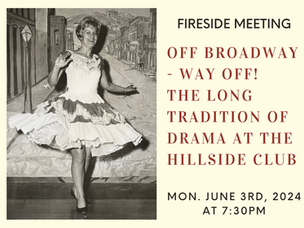
The Hillside Club Fireside Meetings are held on the first Monday of most months (January, February, March, April, June, October, and November).
They are open to the public and admission is free to members, with a suggested donation for non-members. No one is turned away for lack of funds. The meetings begin with social time for members, a brief Club business meeting, followed by a featured speaker.
6:30pm Member Social Time
7:00pm Club Business Meeting
7:30pm A talk from a community member on art, history, science, music, civic life, or culture.
April 7th, 2025 at 7:30pm
A Talk with Kevin Fagan
.png)
Kevin Fagan is a longtime, award-winning reporter at the San Francisco Chronicle, specializing in homelessness, enterprise news-feature writing, breaking news and crime.

 |
|---|
 |
 |
 |
 |
 |
 |
 |
 |
The Hillside Club was founded by a group of Berkeley women who wished to protect the Berkeley hillsides by promoting the development of the community in environmentally sensitive ways.
In 1895, Bernard Maybeck built a steep-roofed, unpainted redwood house for Charles Keeler on the corner of Highland Place and Ridge Road. It was the architect's first Berkeley commission. The house blended with the surrounding hills, and Keeler was worried that the
effect would "become completely ruined when others come and build stupid white-painted boxes all about us." "You must see to it," advised Maybeck, "that all the houses about you are in keeping with your own." The germ had been planted, and Keeler began recruiting his friends to buy land and build artistic houses next to his own.
A year later, Volney Moody, a retired banker, commissioned A.C. Schweinfurth to build him a clinker-brick house on the corner of Le Conte and Le Roy avenues. Keeler persuaded Moody and his family to join his group of neighbors. Moody's two stepdaughters, Margaret Robinson and May Gray, were artistically inclined—Madge (who would later marry the photographer Oscar Maurer) was a writer and lecturer, May a musician. Along with a few other women of the neighborhood, they organized the Hillside Club to disseminate Maybeck's architectural principles in a more formal fashion.
The club's stated mission was "to protect the hills of Berkeley from unsightly grading and the building of unsuitable and disfiguring houses; to do all in our power to beautify these hills and above all to create and encourage a decided public opinion on these subjects."
Thanks to the efforts of these women, the Hillside School was built in 1900 on the corner of Virginia Street and Le Roy Avenue. It was a rustic brown-shingle structure with unpeeled tree trunks serving as porch posts and rough branches making up the porch railing. "For the first time," wrote Keeler, "a note of artistic simplicity had been incorporated in a Berkeley school building."
In 1902, seeking more political clout, the club invited men to join. Among the male members were major business figures such as Frank Wilson, the developer of Daley's Scenic Park; notable artists like William Keith and Oscar Maurer; key university officials, among them U.C. President Benjamin Ide Wheeler and Supervising Architect John Galen Howard; and cultural leaders like Maybeck and Keeler.
In 1905, a lot was purchased on Cedar Street, and Maybeck began designing an artistic clubhouse. The building opened to great acclaim on September 8, 1906. It was the venue for many prominent cultural and social activities. The building was destroyed in the great fire of 1923. A year later, Annie Maybeck's brother, the architect John White, designed the current clubhouse, designated a City of Berkeley Landmark in 2004.
As time passed the club changed its emphasis to include dramatic presentations and a broader range of cultural events, and by the late 1920s a dancing committee was formed. The club's focus changed from civic affairs to the social and cultural life of the members.
During the late 1930s and 1940s regular monthly programs were instituted and continued despite wartime food shortages and rationing which complicated the club dinners. Also, during this time the club did its part for the war effort, opening the club one day a month as a U.S.O. center.
In the 1950s the club relaxed the residence requirements to include new members living in such exotic places as El Cerrito, Lafayette, Walnut Creek, Concord, and San Francisco.
As the times have changed, so has the club, but as one historian commented,"...tradition is the fine cement that binds our club...makes it an organization which is firmly established in Berkeley...adds to its charm...and provides the solidarity so necessary when diverse people
work together." Bernard Maybeck said of the club, “This is an organization of neighbors who like one another
and wish to have a sort of common home for the hours of their meeting together. It must feel that way!”
Even today, in this fast-paced computer age, the Hillside Club provides historical perspective and a sense of community with its social and cultural events.
This picture shows people at the first dinner of the Hillside Club in 1910



Read retrospective article about the Hillside Club in the The East Bay Monthly.
Learn more about local history and architecture.
Visit the Berkeley Architectural Heritage Association.
Read about Bernard Maybeck.





